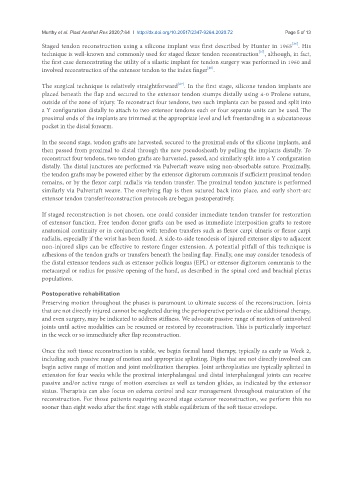Page 755 - Read Online
P. 755
Murthy et al. Plast Aesthet Res 2020;7:64 I http://dx.doi.org/10.20517/2347-9264.2020.72 Page 5 of 13
[26]
Staged tendon reconstruction using a silicone implant was first described by Hunter in 1965 . His
[27]
technique is well-known and commonly used for staged flexor tendon reconstruction , although, in fact,
the first case demonstrating the utility of a silastic implant for tendon surgery was performed in 1960 and
[26]
involved reconstruction of the extensor tendon to the index finger .
[27]
The surgical technique is relatively straightforward . In the first stage, silicone tendon implants are
placed beneath the flap and secured to the extensor tendon stumps distally using 4-0 Prolene suture,
outside of the zone of injury. To reconstruct four tendons, two such implants can be passed and split into
a Y configuration distally to attach to two extensor tendons each or four separate units can be used. The
proximal ends of the implants are trimmed at the appropriate level and left freestanding in a subcutaneous
pocket in the distal forearm.
In the second stage, tendon grafts are harvested, secured to the proximal ends of the silicone implants, and
then passed from proximal to distal through the new pseudosheath by pulling the implants distally. To
reconstruct four tendons, two tendon grafts are harvested, passed, and similarly split into a Y configuration
distally. The distal junctures are performed via Pulvertaft weave using non-absorbable suture. Proximally,
the tendon grafts may be powered either by the extensor digitorum communis if sufficient proximal tendon
remains, or by the flexor carpi radialis via tendon transfer. The proximal tendon juncture is performed
similarly via Pulvertaft weave. The overlying flap is then sutured back into place, and early short-arc
extensor tendon transfer/reconstruction protocols are begun postoperatively.
If staged reconstruction is not chosen, one could consider immediate tendon transfer for restoration
of extensor function. Free tendon donor grafts can be used as immediate interposition grafts to restore
anatomical continuity or in conjunction with tendon transfers such as flexor carpi ulnaris or flexor carpi
radialis, especially if the wrist has been fused. A side-to-side tenodesis of injured extensor slips to adjacent
non-injured slips can be effective to restore finger extension. A potential pitfall of this technique is
adhesions of the tendon grafts or transfers beneath the healing flap. Finally, one may consider tenodesis of
the distal extensor tendons such as extensor pollicis longus (EPL) or extensor digitorum communis to the
metacarpal or radius for passive opening of the hand, as described in the spinal cord and brachial plexus
populations.
Postoperative rehabilitation
Preserving motion throughout the phases is paramount to ultimate success of the reconstruction. Joints
that are not directly injured cannot be neglected during the perioperative periods or else additional therapy,
and even surgery, may be indicated to address stiffness. We advocate passive range of motion of uninvolved
joints until active modalities can be resumed or restored by reconstruction. This is particularly important
in the week or so immediately after flap reconstruction.
Once the soft tissue reconstruction is stable, we begin formal hand therapy, typically as early as Week 2,
including such passive range of motion and appropriate splinting. Digits that are not directly involved can
begin active range of motion and joint mobilization therapies. Joint arthroplasties are typically splinted in
extension for four weeks while the proximal interphalangeal and distal interphalangeal joints can receive
passive and/or active range of motion exercises as well as tendon glides, as indicated by the extensor
status. Therapists can also focus on edema control and scar management throughout maturation of the
reconstruction. For those patients requiring second stage extensor reconstruction, we perform this no
sooner than eight weeks after the first stage with stable equilibrium of the soft tissue envelope.

